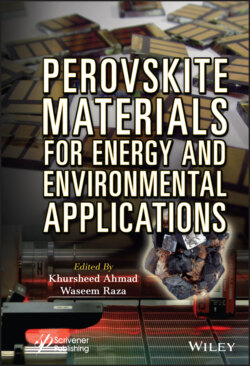Читать книгу Perovskite Materials for Energy and Environmental Applications - Группа авторов - Страница 46
2.5.4.1 Organic Cation (A)
ОглавлениеIn perovskite, structure changes in A do not remarkably alter the structures, but it can alter it to some extent [38]. The structure of the band of CH3NH3PBI3 is near to its optimum value for solar applications, so the small change/alteration will help tune the band gap to its optimum value. NH2-CH=NH2+ (A) is replaced by CH3NH3+ in CH3NH3PbI3 to narrow the band gap. The band gap of perovskite formed after replacing A (NH2-CH=NH2PbI3) is 1.4 eV [39].
Table 2.2 Band gap of different ABX3 materials [32].
| A substitution | M substitution | X substitution | |||
| Material | Band gap (eV) | Material | Band gap (eV) | Material | Band gap (eV) |
| EAPbI3 | 2.2 | MaPbI3 | 1.5 | MAPbI3 | 1.5 |
| MAPbI3 | 1.5 | MASn0.3Pb0.7I3 | 1.31 | MAPbI2Br | 1.8 |
| FAPbI3 | 1.4 | MASn0.5Pb0.5I3 | 1.28 | MAPbBr3 | 2.20 |
| CsPbI3 | 1.67 | MASn0.9Pb0.1I3 | 1.18 | MAPbCl3 | 3.11 |
| MASnI3 | 1.10 |
The bandgap of CsPbI3 is 1.67 eV [40]. The trend that is observed here is increasing the size of “A| cation, i.e., from Cs+ to CH3NH+3 and NH2-CH=NH+2, the value of the bandgap steadily declines [32] as shown in Table 2.2. However, on further increasing the size of “A” to CH3CH2NH2 (EA), the perovskite [CH3CH2NH3]+ PbI3 structure turns into orthorhombic symmetry with a bandgap of 2.2 eV [38].
